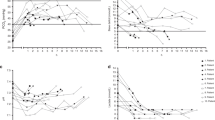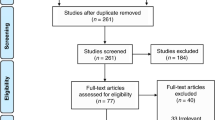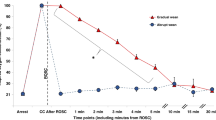Abstract
Objective:
To determine the rate and severity of short- and long-term morbidity in very low birth weight infants treated before and after the implementation of a change in clinical practice designed to avoid hyperoxia.
Methods:
Analysis of a prospectively collected database of all infants ⩽1250?g admitted to two Emory University NICU's from January 2000 to December 2004. A change in practice was instituted in January 2003 with the objective of avoiding hyperoxia in preterm infants with target O2 saturation (SpO2) at 93 to 85% (Period II). Before the change in practice, SpO2 high alarms were set at 100% and low alarms at 92% (Period I). Statistical analysis included bivariate analyses and multivariate logistic regression comparing outcomes between the two periods.
Results:
From January 2000 to December 2004, 502 infants met enrollment criteria and 202 (40%) were born in period II, after change in SpO2 targets. Birth weight, gestational age and survival were similar between both periods. The rates for any retinopathy of prematurity, supplemental oxygen at 36 weeks post-conceptional age and the use of steroids for chronic lung disease were significantly lower in the infants born in Period II. There was no difference in the rates of necrotizing enterocolitis, intraventricular hemorrhage and periventricular leukomalacia. At 18 months corrected age (CA), the infants treated during Period II had a higher Mental Developmental Index (MDI) scores (80.2±18.3 vs 89.2±18.5; P 0.02) and similar Psychomotor Developmental Index (PDI) scores (83.9±18.6 vs 89.4±17.2; P 0.08) than those treated during Period I. The proportion of infants with an MDI or a PDI less than 70 was similar between the periods.
Conclusions:
The change in practice to avoid hyperoxia is associated with a significant decrease in neonatal morbidity and does not have a detrimental effect on developmental outcomes at 18 months CA.
This is a preview of subscription content, access via your institution
Access options
Subscribe to this journal
Receive 12 print issues and online access
$259.00 per year
only $21.58 per issue
Buy this article
- Purchase on Springer Link
- Instant access to full article PDF
Prices may be subject to local taxes which are calculated during checkout

Similar content being viewed by others
References
Wilson-Costello D, Friedman H, Minich N, Fanaroff AA, Hack M . Improved survival rates with increased neurodevelopmental disability for extremely low birth weight infants in the 1990s. Pediatrics 2005; 115: 997–1003.
Haynes RL, Baud O, Li J, Kinney HC, Volpe JJ, Folkerth DR . Oxidative and nitrative injury in periventricular leukomalacia: a review. Brain Pathol 2005; 15: 225–233.
Gressens P, Rogido M, Paindaveine B, Sola A . The impact of neonatal intensive care practices on the developing brain. J Pediatr 2002; 140: 646–653 (Review).
Chow LC, Wright KW, Sola A . Can changes in clinical practice decrease the incidence of severe retinopathy of prematurity in very low birth weight infants? Pediatrics 2003; 111: 339–345.
Tin W . Optimal oxygen saturation for preterm babies. Do we really know? Biol Neonate 2004; 85: 319–325.
Sola A, Chow L, Rogido M . Pulse oximetry in neonatal care in 2005. A comprehensive state of the art review. An Pediatr (Barcelona) 2005; 62: 266–281.
Dommergues MA, Gallego J, Evrard P, Gressens P . Iron supplementation aggravates periventricular cystic white matter lesions in newborn mice. Eur J Paediatr Neurol 1998; 2: 313–318.
Sarco DP, Becker J, Palmer C, Sheldon RA, Ferriero DM . The neuroprotective effect of deferoxamine in the hypoxic-ischemic immature mouse brain. Neurosci Lett 2000; 282: 113–116.
Saugstad OD . Hypoxanthine as an indicator of hypoxia: its role in health and disease through free radical production. Pediatr Res 1988; 23: 143–150.
Saugstad OD . Bronchopulmonary dysplasia-oxidative stress and antioxidants. Semin Neonatol 2003; 8: 39–49.
Ochoa JJ, Ramirez-Tortosa MC, Quiles JL, Palomino N, Robles R, Mataix J et al. Oxidative stress in erythrocytes from premature and full-term infants during their first 72?h of life. Free Radic Res 2003; 37: 317–322.
Zhou Y, Wang Q, Evers BM, Chung DH . Signal transduction pathways involved in oxidative stress-induced intestinal epithelial cell apoptosis. Pediatr Res 2005; 58: 1192–1197.
Solas AB, Munkeby BH, Saugstad OD . Comparison of short- and long-duration oxygen treatment after cerebral asphyxia in newborn piglets. Pediatr Res 2004; 56: 125–131.
Solas AB, Kutzsche S, Vinje M, Saugstad OD . Cerebral hypoxemia–ischemia and reoxygenation with 21% or 100% oxygen in newborn piglets: effects on extracellular levels of excitatory amino acids and microcirculation. Pediatr Crit Care Med 2001; 2: 340–345.
Dohlen G, Carlsen H, Blomhoff R, Thaulow E, Saugstad OD . Reoxygenation of hypoxic mice with 100% oxygen induces brain nuclear factor-kappa B. Pediatr Res 2005; 58: 941–945.
Temesvari P, Karg E, Bodi I, Pinter S, Lazics K, Domoki F et al. Impaired early neurologic outcome in newborn piglets reoxygenated with 100% oxygen compared with room air after pneumothorax-induced asphyxia. Pediatr Res 2001; 49: 812–819.
Handley S, Sola A, Rogido M . Hyperoxia causes oxidative stress and increases neural stem cells proliferation in the murine developing brain. E-PAS 2006; 59: 5168.6 (abstract).
Bayley N . Bayley Scales of Infant Development. The Psychological Corporation: New York, NY, 1969.
Campbell SK, Siegel E, Parr CA, Ramey CT . Evidence for the need to renorm the Bayley Scales of Infant Development based on the performance of a population-based sample of 12-month-old-infants. Topics Child Special Educ 1986; 6: 83–96.
Bayley N . Bayley Scales of Development. 2nd ed manual. The Psychological Corporation, Harcourt Brace & Co: San Antonio, TX, 1993.
Jobe AH, Bancalari E . Bronchopulmonary dysplasia. Am J Respir Crit Care Med 2001; 163: 1723–1729.
International Committee for the Classification of Retinopathy of Prematurity. An international classification of retinopathy of prematurity. Arch Ophthalmol 1984; 102: 1130–1134.
American Academy of Pediatrics, American Academy of Ophthalmology, American Association for Pediatric Ophthalmology and Strabismus. Screening examination of premature infants for retinopathy of prematurity. Pediatrics 1997; 100: 273.
Screening examination of premature infants for retinopathy of prematurity. A joint statement of the American Academy of Pediatrics, the American Association for Pediatric Ophthalmology and Strabismus, and the American Academy of Ophthalmology. Ophthalmology 1997; 104: 888–889.
Papile LA, Burstein J, Burstein R, Koffler H . Incidence and evolution of subependymal and intraventricular hemorrhage: a study of infants with BW less than 1500?gm. J Pediatr 1978; 92: 529–534.
Walsh MC, Kliegman RM, Fanaroff AA . Necrotizing enterocolitis: a practitioner's perspective. Pediatr Rev 1988; 9: 219–226.
Naumburg E, Bellocco R, Cnattingius S, Jonzon A, Ekbom A . Supplementary oxygen and risk of childhood lymphatic leukaemia. Acta Paediatr 2002; 91: 1328–1333.
Spector LG, Klebanoff MA, Feusner JH, Georgieff MK, Ross JA . Childhood cancer following neonatal oxygen supplementation. J Pediatr 2005; 147: 27–31.
Saugstad OD, Ramji S, Vento M . Resuscitation of depressed newborn infants with ambient air or pure oxygen: a meta-analysis. Biol Neonate 2005; 87: 27–34.
Klinger G, Beyene J, Shah P, Perlman M . Do hyperoxaemia and hypocapnia add to the risk of brain injury after intrapartum asphyxia? Arch Dis Child Fetal Neonatal Ed 2005; 90: F49–F52.
Brockway J, Hay Jr WW . Prediction of arterial partial pressure of oxygen with pulse oxygen saturation measurements. J Pediatr 1998; 133: 63–66.
Saugstad OD . Oxygen for newborns: how much is too much? J Perinatol 2005; 25 (Suppl 2): S45–S49 (discussion S50).
Tin W, Milligan DW, Pennefather P, Hey E . Pulse oximetry, severe retinopathy, and outcome at one year in babies of less than 28 weeks gestation. Arch Dis Child Fetal Neonatal Ed 2001; 84: F106–F110.
Askie LM, Henderson-Smart D, Irwig L, Simpson JM . Oxygen-saturation targets and outcomes in extremely preterm infants. N Engl J Med 2003; 349: 959–967.
Supplemental therapeutic oxygen for prethreshold retinopathy of prematurity (STOP-ROP), a randomized, controlled trial. I: Primary Outcomes. Pediatrics 2000; 105: 295–310.
Anderson CG, Benitz WE, Madan A . Retinopathy of prematurity and pulse oximetry: a national survey of recent practices. J Perinatol 2004; 24: 164–168.
Acknowledgements
This work was funded by Goddard Scholarship and ECRC from Emory University.
Author information
Authors and Affiliations
Corresponding author
Rights and permissions
About this article
Cite this article
Deulofeut, R., Critz, A., Adams-Chapman, I. et al. Avoiding hyperoxia in infants ⩽1250?g is associated with improved short- and long-term outcomes. J Perinatol 26, 700–705 (2006). https://doi.org/10.1038/sj.jp.7211608
Received:
Revised:
Accepted:
Published:
Issue Date:
DOI: https://doi.org/10.1038/sj.jp.7211608
Keywords
This article is cited by
-
Reduced rate of treated retinopathy of prematurity after implementing lower oxygen saturation targets
Journal of Perinatology (2019)
-
Urinary Allantoin Is Elevated in Severe Intraventricular Hemorrhage in the Preterm Newborn
Translational Stroke Research (2016)
-
Effects of postnatal hyperoxia exposure on the rat dentate gyrus and subventricular zone
Brain Structure and Function (2015)



